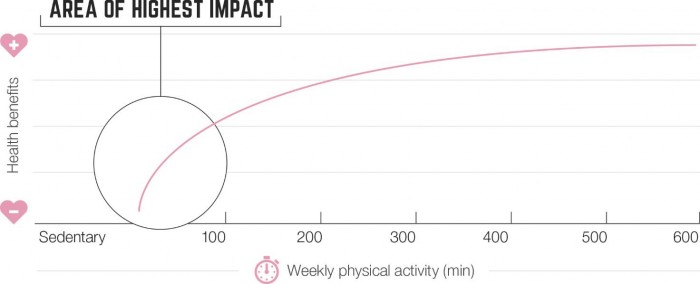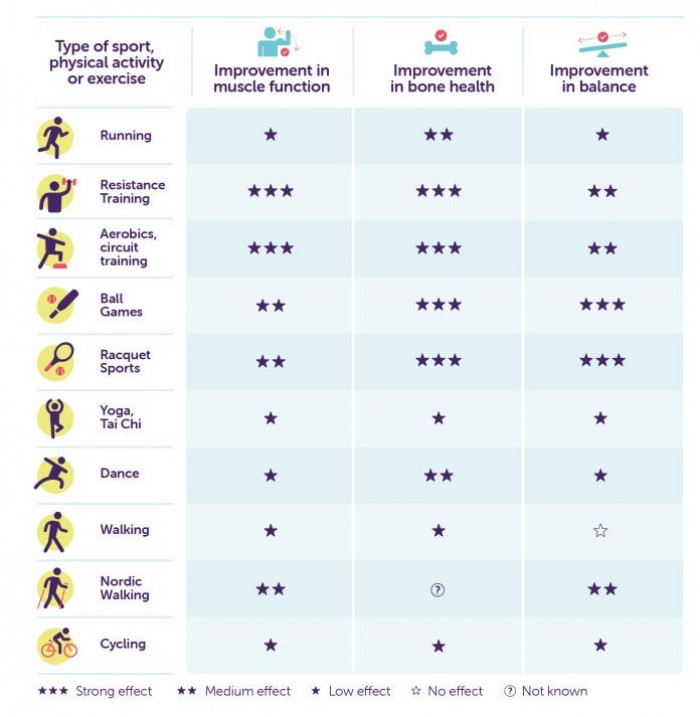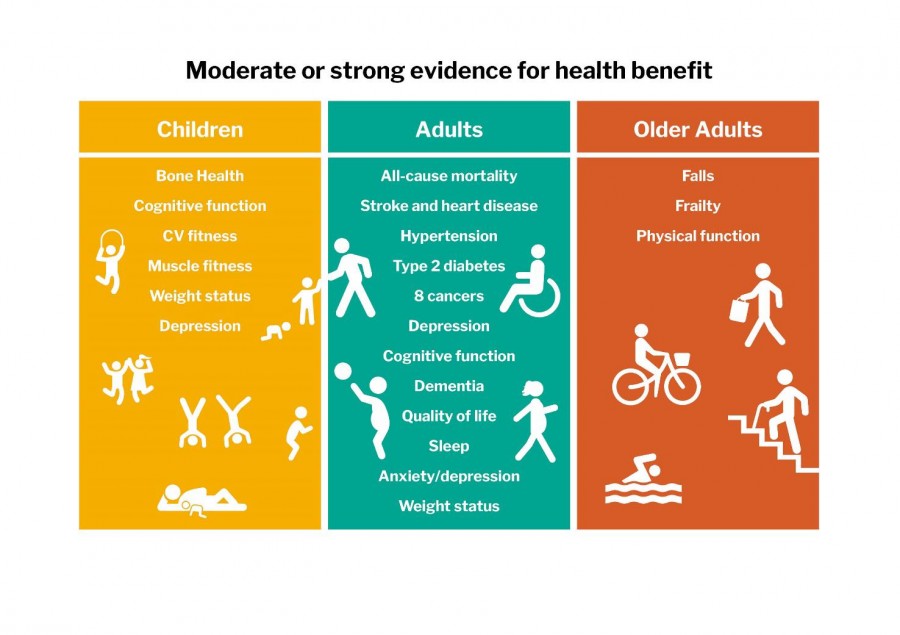Key principles of physical activity
Physical activity for good health and wellbeing
Regular physical activity provides a range of physical and mental health benefits. These include reducing the risk of disease, managing existing conditions and developing and maintaining physical and mental function. More details on the conditions that benefit from physical activity follow in other factsheets of these resources.
Some is good, more is better
Our understanding of the relationship between physical activity and health has grown. In general, the more time spent being physically active, the greater the health benefits. However, we now know that even relatively small increases in physical activity can contribute to improved health and quality of life. The gains are especially significant for those currently engaging in the lowest levels of activity (fewer than 30 minutes per week), as the improvement in health for each additional minute of physical activity will be proportionately greater (Fig 1). Although we recommend that all individuals work towards achieving these guidelines, they are not absolute thresholds and we recognise the benefits that can be achieved at levels both above and below the thresholds. The previous requirement for a 10-minute bout of activity is no longer valid and is no longer included. However, specific targets -such as aiming to do at least 10 minutes at a time -can be effective as a behavioural goal for people starting from low levels of activity. 17
Figure 1: Dose-response curve of physical activity and health benefits.18

Muscle and bone strengthening and balance training activities
Muscle and bone strength play a critical role in ensuring good muscular and skeletal health and in maintaining physical function. When undertaking muscle strengthening activities, it is important to work all the major muscle groups. Bone strengthening involves moderate and high impact activities to stimulate bone growth and repair.
Strengthening activities are important throughout life for different reasons: to develop strength and build healthy bones during childhood and young adulthood; to maintain strength in adulthood; and to delay the natural decline in muscle mass and bone density which occurs from around 50 years of age, maintaining function in later life.
Figure 2: Physical activity for muscle and bone strength across the life course 19,20

Balance training involves a combination of movements that challenge balance and reduce the likelihood of falling 21.
Different activities have differential effects on muscle and bone strength and balance.
Types of activities that can help maintain or improve aerobic capacity, strength, balance and bone health and contribute to meeting the physical activity guidelines 20

Wider benefits of being active
Physical activity not only promotes good health and functioning and helps prevent and manage disease. It also contributes to a range of wider social benefits for individuals and communities.
The relevance and importance of the wider benefits of physical activity for individuals vary according to life stage and various other factors but include: improved learning and attainment, managing stress and improved well-being, improved sleep, the development of social skills and better social interaction.
In addition to the health benefits, increasing physical activity across a population also has social, environmental and economic benefits for communities and wider society.
Cumulative health benefits of physical activity across ages. Adapted from (22)

Assessment of present levels of activity:
In most consultations with patients, opportunities arise where the subject of physical activity may be used for prevention or treatment of disease. Assessing a baseline of activity is recommended to either raise the issue of physical activity, measure progress or help shape any subsequent advice. There are many assessment questionnaires available and two most commonly used are:
The UK General Practice Physical Activity Questionnaire (GPPAQ) 23 can be used to categorize patients into recommended levels of activity. Download the GPPAQ questionnaire and Read codes here: 23 https://www.gov.uk/government/publications/general-practice-physical-activity-questionnaire-gppaq
The Scot-PASQ 24 A brief assessment using just three questions. Used as a motivational screening tool to help raise the issue of physical activity and deliver advice
- In the past week, on how many days have you been physically active for a total of 30 minutes or more?
- If four days or less, have you been physically active for at least two and a half hours (150 minutes) over the course of the past week?
- Are you interested in being more physically active?
Read the brief guidance on how to use the Scot-PASQ tool by downloading it here: 24
http://www.healthscotland.com/uploads/documents/20388-ScreeningTools.pdf
Take home messages:
- Physical activity is an important part of the lifestyle for any patient because of the overwhelming evidence of the health benefits at all ages.
- Being active every day provides a foundation for a healthier and happier life.
- Even relatively small increases in physical activity can contribute to improved health and quality of life.
- Regular strength and balance activities are important throughout life: being strong makes all movement easier and increases our ability to perform normal daily tasks.
- Any activity is better than none.
Read the full CMO report in English or Welsh here: https://www.gov.uk/government/publications/physical-activity-guidelines-uk-chief-medical-officers-report
Read the NICE guidelines on Physical activity: brief advice for adults in primary care PH44 here: https://www.nice.org.uk/guidance/ph44
Consider:
- Auditing your patients to see if they have been offered any physical activity advice.
- Advising on diagnosis of the importance of this lifestyle approach for their own well-being.
Benefits for health professionals: Reduced admissions, drug costs, appointments and visits.
Signpost patients to: the public website Benefit from Activity
Glossary:
Aerobic exercise is brisk exercise that promotes the circulation of oxygen through the blood and is associated with an increased rate of breathing.
Balance is the ability to maintain equilibrium while moving or while stationary. Balance activities are those activities that involve the maintenance of the body balance while stationary or moving. They are an essential part of life as we get older to prevent falls and particularly when going to the bathroom, bed or getting up from a chair.
Bone health includes bone quality that refers to the capacity of bones to withstand a wide range of loading without breaking. Bone health also includes bone mineral content, structure, geometry and strength.
Flexibility is the range of motion available at a joint or group of joints. Essential for daily living in bending e.g. to put socks and shoes on or rotating to look behind you.
Metabolic Equivalent of Task (MET) is the objective measure of the ratio of the rate at which a person expends energy, relative to the mass of that person, while performing some specific physical activity compared to the energy expended whilst sedentary.
Moderate physical activity (MPA) is an activity that requires a moderate amount of effort and noticeably accelerates heart and breathing rate, with brisk walking being the easiest example to recognize.
Moderate-to-vigorous physical activity (MVPA) are activities that can be done at different intensities like cycling. They can be differentiated by the ‘talk test’: being able to talk but not sing indicates moderate intensity activity, while having difficulty talking without pausing is a sign of vigorous activity
Muscle Strength is the force or tension that a muscle or muscle group can exert against a resistance in one maximal effort. In practical terms this is the ability to climb stairs, get out of a chair or bath, the ability to walk to the shops and is essential as we age to reduce the risk of falls.
Physical activity is defined as any bodily movement produced by skeletal muscles that results in energy expenditure.... Exercise is a subset of physical activity that is planned, structured, and repetitive and has as a final or an intermediate objective the improvement or maintenance of physical fitness.
Postpartum refers to a period of time after the end of pregnancy. The postpartum period is commonly defined as up to six weeks following the end of pregnancy, with the late postpartum period from six weeks up to one year after the end of pregnancy. For the CMO guidelines postpartum includes up to one year post delivery.
Sedentary behaviour. Inactive and sedentary behaviours are those involving being in a sitting, reclining or lying posture during waking hours, undertaking little movement/activity and using little energy above what is used at rest. Common sedentary behaviours include TV viewing, video game playing, computer screen time, driving and reading.
Vigorous physical activity (VPA) is an activity that requires a large amount of effort and causes rapid breathing and substantial increase in heart rate.
Acknowledgments: I would like to thank the contributing authors and members of the UK CMO Guidelines writing Group (listed in the full guidance document). Additional thanks to Dr Charlie Foster and Professor Russ Jago of the Centre for Exercise, Nutrition and Health Sciences at the University of Bristol, Fiona Cunnah of the Public Health Division of the Welsh Government and Malcolm Ward of Public Health Wales, for their help in making this summary of the CMO physical activity guidelines.
Chapter 1 - CMO Guidelines - Factsheet - download
Now part of the RCGP clinical programme on physical activity and lifestyle
References: Can be found in Chapter 18
This summary of guidelines has been endorsed by the Royal College of General Practitioners (RCGP), British Association of Sport and Exercise Medicine (BASEM), Chartered Society of Physiotherapists (CSP) and the Royal College of Nursing (RCN)




